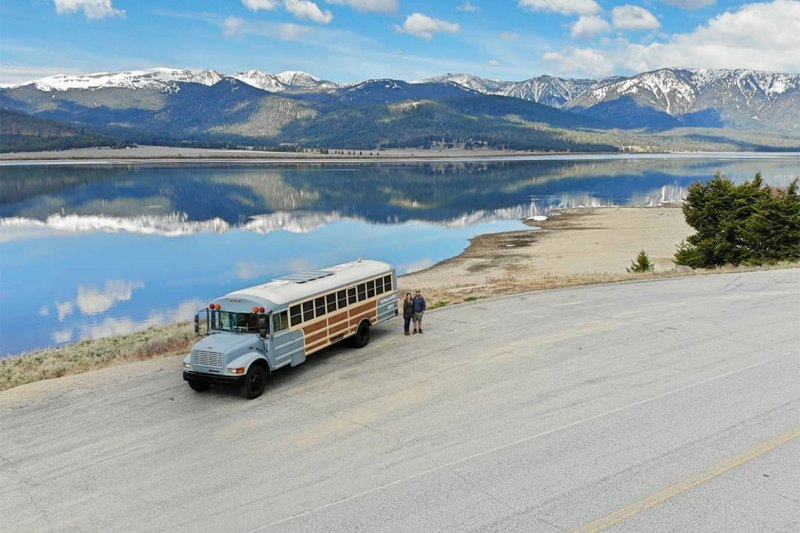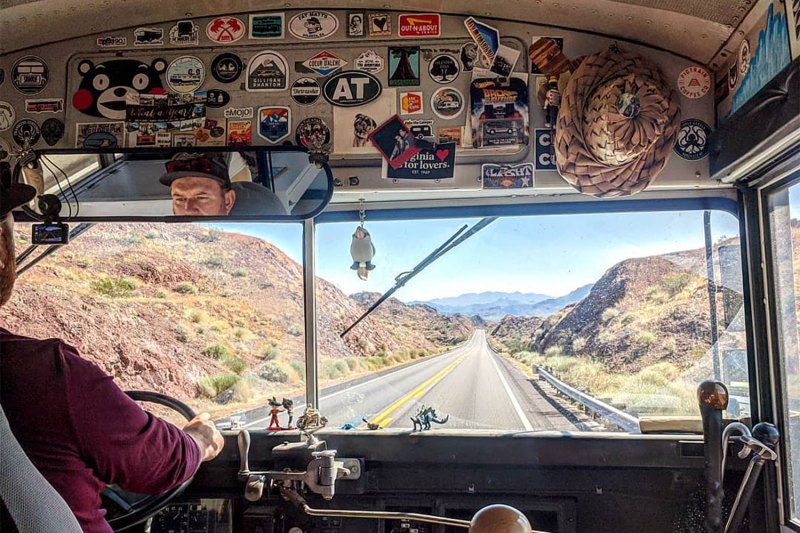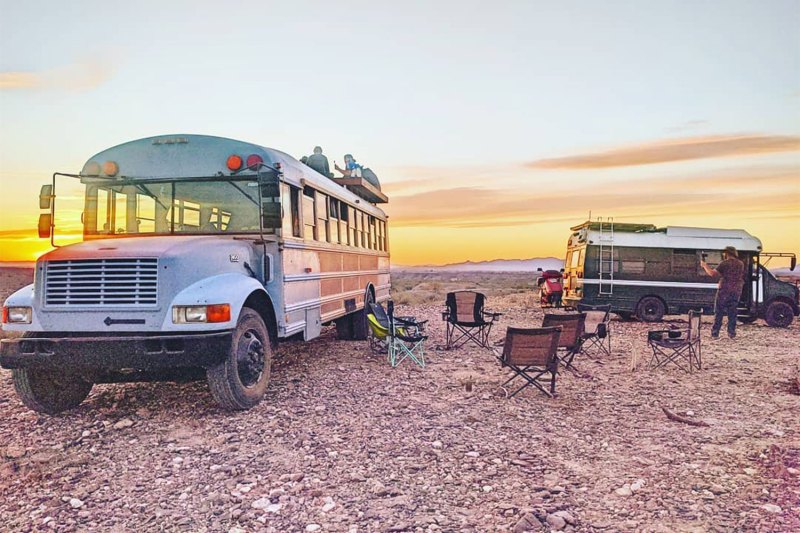Road trips, camping, and RVing are coming back in a big way this summer as the pandemic forces people to consider more socially distanced methods of traveling. But while hitting the road, you may see a new, growing breed of home-on-wheels roaming down the highway or pulling into the slot next to yours at the campground. It’ll look familiar, bringing a twinge of nostalgia from childhood days, but with a fresh coat of paint and some fancy new trimmings. You’ll be reminded of torn vinyl seats covered in scribbles, chatting with friends in front or behind you, and difficult-to-pull-down windows that stick in their frames. You probably rode in one of these twice a day for most of your young life.
That’s right; it’s a school bus. But it no longer ferries kids to and from school. Now it takes everyone from young couples to entire families on adventures, outfitted with living areas, kitchens, bathrooms, and bedrooms that allow them to pursue lives behind-the-wheel. And it has a new name, too: A skoolie.

Increasingly, skoolies are becoming the go-to answer for folks looking to embrace a more nomadic life without having to give up all the comforts of home, spurred by current DIY, minimalism, and tiny living movements, as well as social media and increasing consciousness about how our consumption-based lifestyles negatively impact the planet. While the Van Life craze has been beckoning people back to the road for years, many people don’t want to live in such a small, cramped space; skoolies are much roomier while still allowing for the freedom to roam.
“We feel like we’re in the golden age of it,” says skoolie owner Elizabeth Hensley, who, along with her partner Richard Tilford, have been on the road for two years.
“We’re definitely seeing an upward trend,” agree Nick Berezovski and Nick Sejda, the creators of the National Skoolie Association, a digital community connecting and offering resources for current and prospective skoolie owners.
While it’s impossible to know for sure how many skoolies are out there, both in the United States and abroad in places like Europe and Australia, organizations like the National Skoolie Association, Facebook groups, and Instagram accounts have thousands of members; one Facebook group where owners can sell skoolies, ask questions, and connect with fellow owners has 22,000 members. The National Skoolie Association’s Instagram page has over 15,000 followers and reports a high level of engagement. Events and gatherings, like the yearly Skooliepalooza in the Arizona desert, attract hundreds of skoolie attendees. And just a quick search for “skoolie” on Instagram, YouTube, and other social media sites makes it plain to see: Skoolies are all the rage right now.
In recent years, there’s been a big jump in skoolie accounts on sites like Instagram and YouTube, where owners chronicle the renovation process and their adventures on the road. A 2017 documentary film called Expedition Happiness, about a couple converting a school bus and driving around North America, also brought attention to the growing trend. With their focus on DIY renovations, chic interior design, travel, and outdoor adventures — all forms of content catnip — skoolies are natural stars of social media, with accounts amassing tens of thousands of followers. Owners will give their skoolies fun names like A Bus Named Sue or 2 Cool 4 Skool and write the names on the exterior so travelers can find them online and follow them. For digital nomads and creatives, skoolies are a perfect opportunity to express their artistic side while living a life of adventure on the open road.
One popular account is Hensley and Tilford’s skoolie, Little House on the HWY. The pair bought a 1996 Thomas International school bus in 2018, renovated it, and have been on the go ever since, visiting 47 states and clocking over 30,000 miles in a few short years.

“We were looking for ways to travel, have more adventures, and this was the answer,” they say.
In many ways, living and traveling in a skoolie is much the same as doing so in a small camper or RV, with similar logistical challenges. You set up camp in all sorts of places: Campsites, rest areas, Walmart parking lots, and the driveways or properties of friends, family, or kindly strangers. There’s not a lot of privacy or personal space. Sometimes it’s difficult to maneuver the skoolie along tight roads. Access to utilities and resources like water, graywater and waste disposal, and energy for electricity can be restricted or difficult to find in remote areas, so you constantly need to take stock of what you have on hand and have back-up plans. Usually, this just requires some quick thinking and planning ahead, but when the pandemic first hit, many skoolie owners had to crash in the driveways of friends and family or even go off-grid when campgrounds, RV parks, public lands, and even gyms (which some skoolie owners use for access to showering facilities) closed.
But the rewards are also ample: The freedom to be spontaneous and travel wherever you want, not feeling tied down, and living a low-cost, low-impact life. “We’re really happy we’ve done this,” Hensley says. “We’ve had all these experiences now that we otherwise may not have had.”
Even though they’ve embraced a life of travel, with constant shifting and uprooting from place to place, no skoolie is an island; there’s a thriving community of skoolie owners in the United States and around the world that keep in touch online even when scattered to the winds through platforms like the National Skoolie Association, which was launched by Berezovski and Sejda in fall 2019.
“We wanted to build a community but also give people a platform to learn more about skoolies,” the duo says. Through the Association, skoolie owners can swap everything from advice on design and construction to feedback on the best places to stay while driving through certain areas.
“We’ve all become really good friends in the skoolie community,” says Hensley. “We have a lot in common, like a willingness to sell everything and uproot your life.”
Apart from the lure of unlimited travel and adventure, there are many reasons skoolies are becoming an increasingly attractive option, one of the most notable being adopting a minimalist lifestyle. Minimalism has moved center stage in recent years, spurred by the growing interest in tiny living. Rejected by some as hippie or alternative-lifestyle pablum, minimalism is now being embraced by a generation that’s increasingly disillusioned with capitalism, rejecting entrenched ideas about how to live and becoming more aware of their impact on the environment. Living a minimal life reduces a person’s environmental footprint, as well as freeing them mentally and physically from the burdens of consumption and amassing unnecessary goods.
“It’s difficult to downsize but you really have to ask yourself, do I really need this?” Berezovski and Sejda explain. “The less you have, the happier you are.”
“Once you start getting rid of stuff, you train your mind,” Hensley agrees, who struggled at first with downsizing but found it to be freeing. “These items were preventing us from doing the things we wanted to do.”
And as more jobs move online or can be done remotely, skoolie owners have the ability to balance career and travel; all you need is an internet connection and you’re tuned into work. If they have a big following on social media, some skoolie owners can even make money through those accounts (skool-influencers, if you will). But one of the easiest ways to make money while living in a skoolie is an old standby for travelers and nomads: Go where the jobs are. Traveling from state to state to take on short-term seasonal jobs offers solid sources of income as well as the ability to travel and discover different parts of the country. Even though Hensley and Tilford hold mobile jobs, they also take advantage of these seasonal positions, like helping with a sugarbeet harvest or working on a Christmas tree farm in Florida.
Another big plus is the DIY aspect; the ability to restore the bus completely to your liking, instead of having to make do with cookie-cutter RV or camper layouts and decor.
“It’s like a blank canvas,” Tilford says. He and Hensley redid the outside of their bus with robin’s egg blue paint and wood paneling and refurbished the interior with white walls, blue accents, and charming accessories.
The amount of time it takes to convert a skoolie varies as well; for owners who are able to focus on the rebuild full-time, it can only take a few weeks, but many owners, like Hensley and Tilford, worked on their skoolie on the weekends. It took them about three months of part-time building and then one month of full time to get Little House on the HWY ready to roll.

“It’s a phenomenal resource and a fantastic platform,” Berezovski and Sejda enthuse, and Hensley and Tilford agree wholeheartedly. “YouTube helped a lot!”
Having access to online resources like YouTube and skoolie communities is indispensable because the majority of skoolie owners carry out their conversions entirely on their own, learning everything from carpentry to plumbing in the process. Although Tilford had some prior experience in construction, converting their bus still required a lot of DIY firsts for him and Hensley, starting with ripping up the seats and bolts during the physically taxing demo period and then moving on to planning the layout and design of the bus.
“Most people are doing the construction themselves, learning as they go,” say Berezovski and Sejda. “Learning how to build your entire home from scratch … that’s an amazing accomplishment.”
Then there’s the price tag: skoolies are a fraction of the cost of an RV or camper. A used school bus can be bought on Craigslist for a couple thousand (Hensley and Tilford bought theirs for $2,500) and then completely renovated for ten grand or so. The Little House on the HWY conversion cost around $11,000. Berezovski and Sejda report that, on average, skoolie owners pay around $15,000 for the conversion process. While some lower-end RVs and campers may be in the same price range, you don’t have the option or benefit of getting to customize your layout and decor. “You can personalize it to your liking,” they say.
These customizations run the gamut from ultra-modern to rustic chic; amenities can include everything from subway-tiled showers to cozy corners with wood-burning stoves for warmth and ambiance. Some owners panel the interior in wood for a cabin-like vibe. People add bathrooms, kitchenettes, and dining areas that double as work or hangout spaces during the day. Hensley and Tilford added a deck on top of the bus. The only limit is the imagination, although Hensley and Tilford do caution about being realistic and not biting off more than you can chew.
Using school buses for transportation and living accommodations has been around since the start of the hippie movement in the sixties. Stereotypes about “dirty hippies” still persist to this day, so some skoolie owners have reported getting pushback at rental sites, RV parks, and storage locations from people unfamiliar with the new skoolie movement.
“People have preconceived notions in their heads,” Hensley says, adding that she and Tilford are always willing to welcome curious passersby onto the bus to show them what it’s like and help educate people about the skoolie lifestyle.

Berezovski and Sejda agree that, as more and more people see skoolies on the road and learn about them, negative perceptions are being altered.
“Skoolies had a bad place in people’s minds in years prior,” they say. “But when people see them on the road or in campsites … it’s a full-on beautiful house on wheels, and with such friendly people. It changes their minds.”
Taking their cue from the original skoolie owners of the sixties, many of the attitudes, beliefs, and goals of the current wave of skoolie owners are still deeply rooted in that original movement: A desire to shake off the status quo and live on your own terms. And the movement doesn’t seem to be showing any signs of slowing down.
“We get something like five to ten messages a week from folks asking ‘how do we get started,’” Berezovski and Sejda say, urging anyone who is interested in learning more or taking the leap to reach out to skoolie owners to ask questions. “Don’t be afraid to go against the norm. You only have one life.”
“Listen to that voice that’s telling you to do it,” Hensley and Tilford agree. “You have that window of opportunity, don’t wait. Embrace the unknown.”



